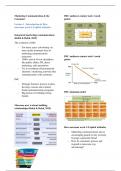Marketing Communication & the IMC audience contact tools / touch
Consumer points
Lecture 1 | Introduction & How
marcoms work I: Explicit attitudes
Integrated marketing communications
(Belch & Belch, 2015)
The evolution of IMC
- For many years: advertising via
mass media dominant form of
marketing communication
(marcom) IMC audience contact tools / touch
- 1980s: arrival of new disciplines points
like public affairs, PR, direct
marketing, sales promotion
- Try to coordinate all promotional
elements / marketing activities that
communication with customers
IMC
- Strategic business process to plan,
develop, execute and evaluate
brand communications programs
- Big-picture on building strong IMC planning model
brands
Marcoms now is about building
relationships (Belch & Belch, 2015)
How marcoms work I: Explicit attitudes
- Marketing communications aim at
encouraging people to buy (or keep
buying) a particular brand
- How do consumers process and
respond to marcoms (e.g.
advertising)?
, 3 components
- Affective; feelings associated with
object
- Cognitive; knowledge, beliefs and
evaluation of object
- Behavioural; action readiness with
object
How do consumers process and respond to
- Analyze receiver’s response marcoms?
processes
- Analyze source, message, channel - Difficult to predict
factors - Influenced by many factors (e.g.
- Establish communication goals and product type, involvement,
objectives situation)
- No single model
Classifying models/processes, 2
How marcoms work dimensions
- basic of attitude formation
o Primarily cognitive vs
affective vs behavioral
- Elaboration level of marcoms
message
o High vs low
o Depends on MAO factors
MAO factors
- M otivation
- Attitude formation and change Willingness to engage in behavior,
o Attitude components makes decisions, pay attention,
o Elaboration likelihood process information, etc
- A bility
Attitude formation and change Resources needed to achieve
Attitude toward the brand (Ab) particular goal
- O pportunity
- How much person likes/dislikes Extent to which situation enables
brand person to obtain goal
- Extent to which hold
favorable/unfavorable view brand Effects MAO on marcoms processing:
ELM
,Classifying models/processes Marcoms can try to change
attitudes/behavior by:
Cognitive attitude formation, low
Cognitive attitude formation, high
elaboration likelihood
elaboration likelihood
- E.g. when consumer don’t have the
- E.g. consumer who wants to buy
time to compare all available
home cinema system and tries to
brands on relevant attributes
compare objectively different
- Peripheral processing
brands on several attributes (price,
- Heuristic evaluation brand
sound, quality, etc) before making
attitudes based on peripheral cues
decision
- Satisficing vs maximizing brand
Relevant models choice
- Self-generated persuasion Potential heuristic cues
- Multi-attribute models
o Expectancy-value model,
TPB (Ajzen / Fishbein)
Theory of planned behaviour: brand
attitudes
3 elements brand attitudes
- Relevant product attributes
- Evaluation of these attributes
- How much consumer believes the Affective attitude formation, low
brand has these attributes elaboration likelihood
- Peripheral processing of mainly
affective elements
Relevant models
- Attitude towards the ad (Aad)
transfer / feelings transfer
- Mere exposure
- Classical/emotional conditioning
, Classical (or emotional or evaluative)
conditioning
Aad transfer: dual mediation hypothesis
- A change in liking of a stimulus
results from pairing this stimulus
with other stimulus
- 1st stimulus = conditional stimulus
(CS)
- 2nd stimulus = unconditioned
stimulus (US)
- CS becomes more positive when
repeatedly paired with a positive
US
- Positive evaluation ad may be - By pairing the product with
transferred to evaluation of the pleasant, liked events it is hoped
brand. If positive attitude towards that a bit of the linking ‘rubs of’ on
ad: the product and that because of this,
o More likely to be receptive consumers will afterwards be more
to arguments/cues in favor likely to buy the product
of brand advertised
o Less likely to think of other e.g. Have a coke and a smile ads of Coca
counter-arguments Cola
- Mere exposure
o Prior exposure to stimuli
(words, slogans, pictures,
sounds, etc) increases
positive affect towards these
stimuli
Ad/brand exposure
can increase
ad/brand liking, and
increases likelihood https://www.youtube.com/watch?
of entering v=qI_L7dF3OdY
consideration set
o Explanation; processing https://www.youtube.com/watch?
fluency v=H8SMoUtZUmU
o Limits: novel stimuli, wear- https://www.youtube.com/watch?
out v=eBy5x5qtgPs




